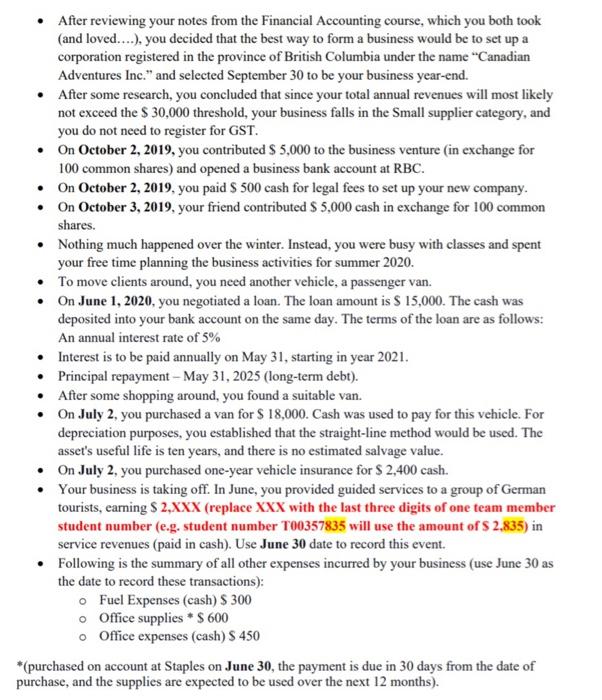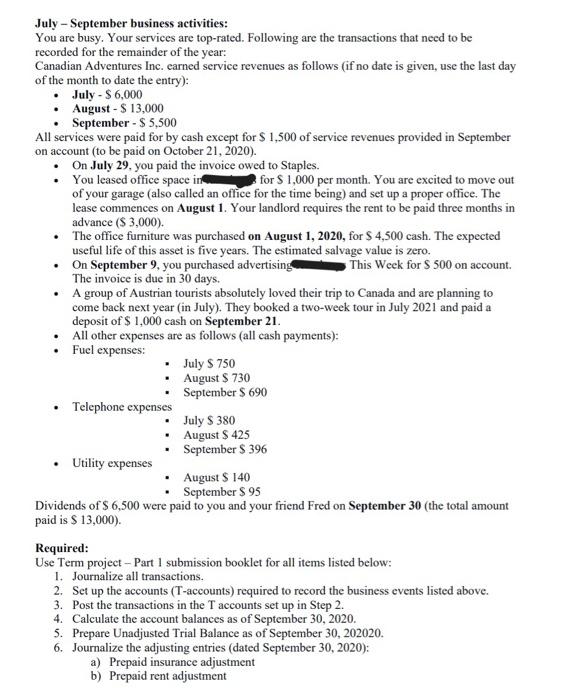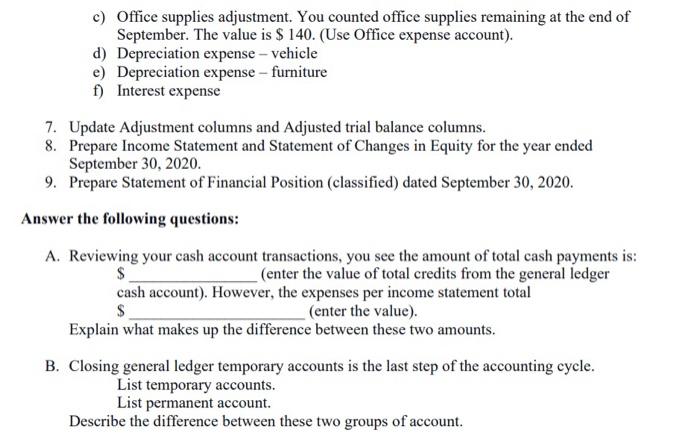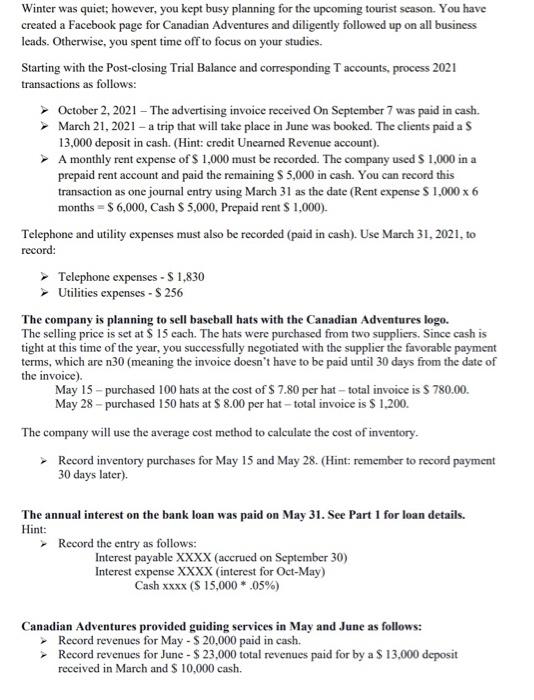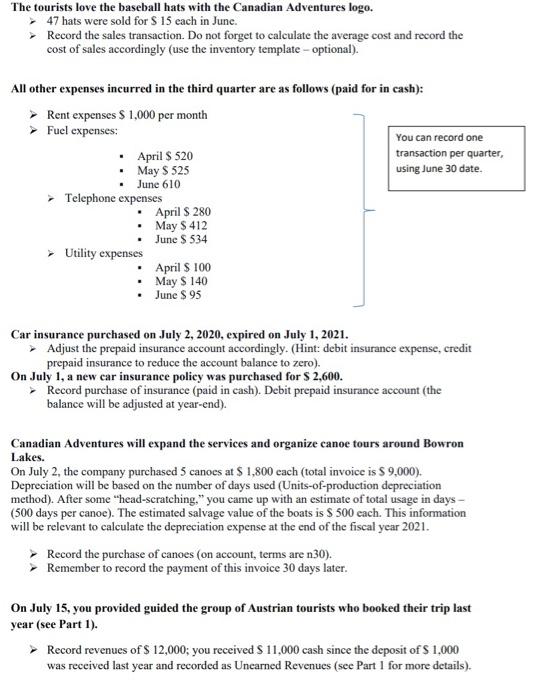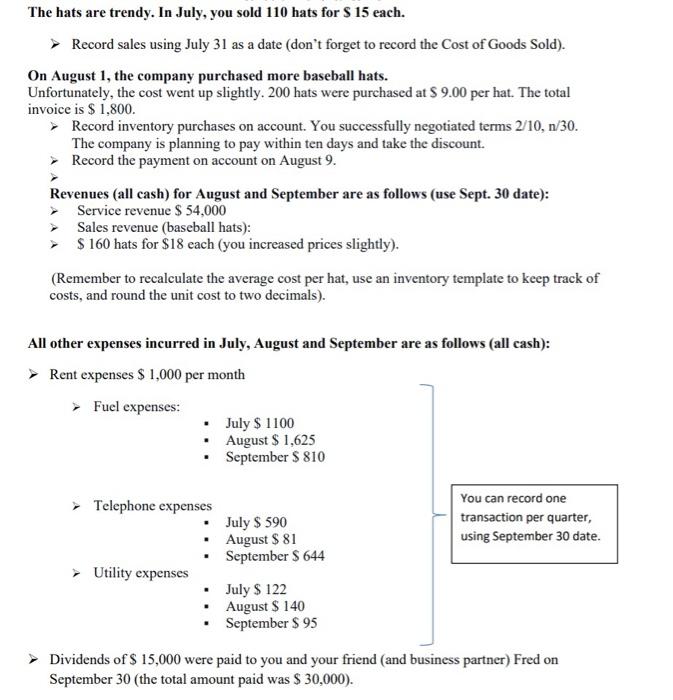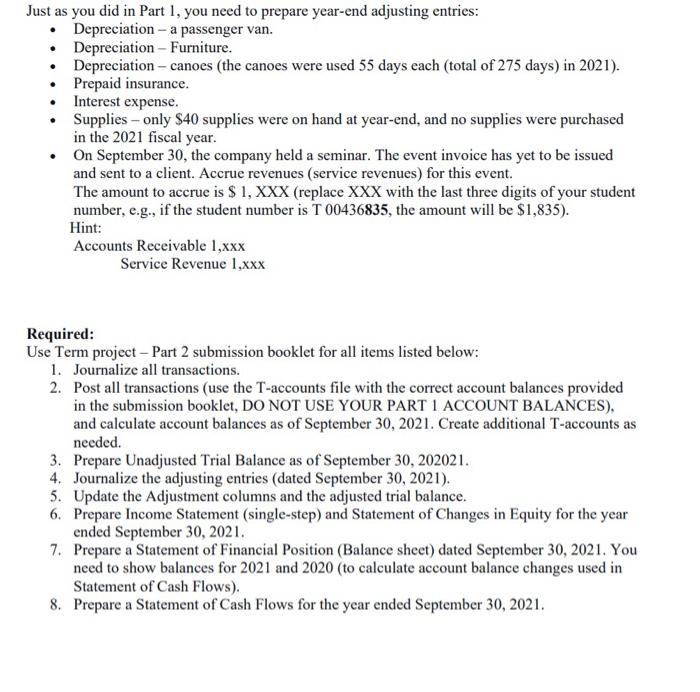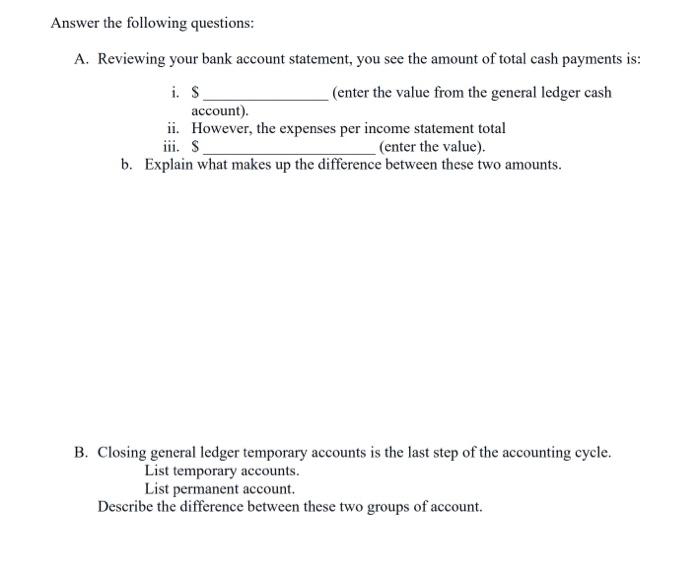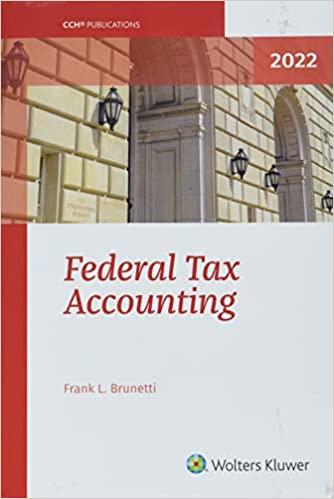After reviewing your notes from the Financial Accounting course, which you both took
(and loved), you decided that the best way to form a business would be to set up a
corporation registered in the province of British Columbia under the name "Canadian
Adventures Inc." and selected September 30 to be your business year-end.
After some research, you concluded that since your total annual revenues will most likely
not exceed the $ 30,000 threshold, your business falls in the Small supplier category, and
you do not need to register for GST.
On October 2, 2019, you contributed $ 5,000 to the business venture (in exchange for
100 common shares) and opened a business bank account at RBC.
On October 2, 2019, you paid $ 500 cash for legal fees to set up your new company.
On October 3, 2019, your friend contributed $ 5,000 cash in exchange for 100 common
shares.
Nothing much happened over the winter. Instead, you were busy with classes and spent
your free time planning the business activities for summer 2020.
To move clients around, you need another vehicle, a passenger van.
On June 1, 2020, you negotiated a loan. The loan amount is $ 15,000. The cash was
deposited into your bank account on the same day. The terms of the loan are as follows:
An annual interest rate of 5%
Interest is to be paid annually on May 31, starting in year 2021.
Principal repayment - May 31, 2025 (long-term debt).
After some shopping around, you found a suitable van.
On July 2, you purchased a van for $ 18,000. Cash was used to pay for this vehicle. For
depreciation purposes, you established that the straight-line method would be used. The
asset's useful life is ten years, and there is no estimated salvage value.
On July 2, you purchased one-year vehicle insurance for $ 2,400 cash.
- After reviewing your notes from the Financial Accounting course, which you both took (and loved....), you decided that the best way to form a business would be to set up a corporation registered in the province of British Columbia under the name "Canadian Adventures Inc." and selected September 30 to be your business year-end. - After some research, you concluded that since your total annual revenues will most likely not exceed the $30,000 threshold, your business falls in the Small supplier category, and you do not need to register for GST. - On October 2, 2019, you contributed $5,000 to the business venture (in exchange for 100 common shares) and opened a business bank account at RBC. - On October 2, 2019, you paid S 500 cash for legal fees to set up your new company. - On October 3, 2019, your friend contributed \$ 5,000 cash in exchange for 100 common shares. - Nothing much happened over the winter. Instead, you were busy with classes and spent your free time planning the business activities for summer 2020. - To move clients around, you need another vehicle, a passenger van. - On June 1, 2020, you negotiated a loan. The loan amount is S 15,000. The cash was deposited into your bank account on the same day. The terms of the loan are as follows: An annual interest rate of 5% - Interest is to be paid annually on May 31, starting in year 2021. - Principal repayment - May 31, 2025 (long-term debt). - After some shopping around, you found a suitable van. - On July 2, you purchased a van for $18,000. Cash was used to pay for this vehicle. For depreciation purposes, you established that the straight-line method would be used. The asset's useful life is ten years, and there is no estimated salvage value. - On July 2, you purchased one-year vehicle insurance for $2,400 cash. - Your business is taking off. In June, you provided guided services to a group of German tourists, earning $2,XXX (replace XXX with the last three digits of one team member student number (e.g. student number T00357835 will use the amount of S 2.835) in service revenues (paid in cash). Use June 30 date to record this event. - Following is the summary of all other expenses incurred by your business (use June 30 as the date to record these transactions): Fuel Expenses (cash) $300 Office supplies * $600 Office expenses (cash) $450 *(purchased on account at Staples on June 30, the payment is due in 30 days from the date of purchase, and the supplies are expected to be used over the next 12 months). July - September business activities: You are busy. Your services are top-rated. Following are the transactions that need to be recorded for the remainder of the year: Canadian Adventures Inc. earned service revenues as follows (if no date is given, use the last day of the month to date the entry): - July $6,000 - August - $13,000 - September - $5,500 All services were paid for by cash except for $1,500 of service revenues provided in September on account (to be paid on October 21, 2020). - On July 29, you paid the invoice owed to Staples. - You leased office space in_ for $1,000 per month. You are excited to move out of your garage (also called an office for the time being) and set up a proper office. The lease commences on August 1. Your landlord requires the rent to be paid three months in advance ($3,000). - The office furniture was purchased on August 1, 2020, for $4,500 cash. The expected useful life of this asset is five years. The estimated salvage value is zero. - On September 9, you purchased advertising This Week for $500 on account. The invoice is due in 30 days. - A group of Austrian tourists absolutely loved their trip to Canada and are planning to come back next year (in July). They booked a two-week tour in July 2021 and paid a deposit of \$ 1,000 cash on September 21. - All other expenses are as follows (all cash payments): - Fuel expenses: - July $750 - August $730 - September $690 - Telephone expenses - July $380 - August $425 - September $396 - Utility expenses - August $140 - September $95 Dividends of $6,500 were paid to you and your friend Fred on September 30 (the total amount paid is $13,000 ). Required: Use Term project - Part 1 submission booklet for all items listed below: 1. Journalize all transactions. 2. Set up the accounts (T-accounts) required to record the business events listed above. 3. Post the transactions in the T accounts set up in Step 2. 4. Calculate the account balances as of September 30,2020. 5. Prepare Unadjusted Trial Balance as of September 30,202020. 6. Journalize the adjusting entries (dated September 30, 2020): a) Prepaid insurance adjustment b) Prepaid rent adjustment c) Office supplies adjustment. You counted office supplies remaining at the end of September. The value is \$ 140. (Use Office expense account). d) Depreciation expense - vehicle e) Depreciation expense - furniture f) Interest expense 7. Update Adjustment columns and Adjusted trial balance columns. 8. Prepare Income Statement and Statement of Changes in Equity for the year ended September 30,2020. 9. Prepare Statement of Financial Position (classified) dated September 30, 2020. Answer the following questions: A. Reviewing your cash account transactions, you see the amount of total cash payments is: $ (enter the value of total credits from the general ledger cash account). However, the expenses per income statement total $ (enter the value). Explain what makes up the difference between these two amounts. B. Closing general ledger temporary accounts is the last step of the accounting cycle. List temporary accounts. List permanent account. Describe the difference between these two groups of account. Winter was quiet; however, you kept busy planning for the upcoming tourist season. You have created a Facebook page for Canadian Adventures and diligently followed up on all business leads. Otherwise, you spent time off to focus on your studies. Starting with the Post-closing Trial Balance and corresponding T accounts, process 2021 transactions as follows: October 2, 2021 - The advertising invoice received On September 7 was paid in cash. March 21, 2021 - a trip that will take place in June was booked. The clients paid a S 13,000 deposit in cash. (Hint: credit Unearned Revenue account). A monthly rent expense of $1,000 must be recorded. The company used $1,000 in a prepaid rent account and paid the remaining $5,000 in cash. You can record this transaction as one journal entry using March 31 as the date (Rent expense $1,0006 months =$6,000, Cash $5,000, Prepaid rent $1,000 ). Telephone and utility expenses must also be recorded (paid in cash). Use March 31, 2021, to record: Telephone expenses $1,830 Utilities expenses - \$ 256 The company is planning to sell baseball hats with the Canadian Adventures logo. The selling price is set at $15 each. The hats were purchased from two suppliers. Since cash is tight at this time of the year, you successfully negotiated with the supplier the favorable payment terms, which are n30 (meaning the invoice doesn't have to be paid until 30 days from the date of the invoice). May 15 - purchased 100 hats at the cost of $7.80 per hat - total invoice is $780.00. May 28 - purchased 150 hats at $8.00 per hat - total invoice is $1,200. The company will use the average cost method to calculate the cost of inventory. Record inventory purchases for May 15 and May 28. (Hint: remember to record payment 30 days later). The annual interest on the bank loan was paid on May 31. See Part 1 for loan details. Hint: Record the entry as follows: Interest payable XXXX (accrued on September 30) Interest expense XXXX (interest for Oct-May) Cash xxxx($15,000.05%) Canadian Adventures provided guiding services in May and June as follows: Record revenues for May $20,000 paid in cash. Record revenues for June $23,000 total revenues paid for by a $13,000 deposit received in March and $10,000 cash. The tourists love the baseball hats with the Canadian Adventures logo. 47 hats were sold for $15 each in June. Record the sales transaction. Do not forget to calculate the average cost and record the cost of sales accordingly (use the inventory template - optional). All other expenses incurred in the third quarter are as follows (paid for in cash): Rent expenses \$ 1,000 per month Fuel expenses: - April \$520 - May $525 - June 610 Telephone expenses - April \$280 - May $412 - June $534 Utility expenses - April \$100 - May $140 - June $95 You can record one transaction per quarter, using June 30 date. Car insurance purchased on July 2, 2020, expired on July 1, 2021. Adjust the prepaid insurance account accordingly. (Hint: debit insurance expense, credit prepaid insurance to reduce the account balance to zero). On July 1, a new car insurance policy was purchased for $2,600. Record purchase of insurance (paid in cash). Debit prepaid insurance account (the balance will be adjusted at year-end). Canadian Adventures will expand the services and organize canoe tours around Bowron Lakes. On July 2, the company purchased 5 canoes at $1,800 each (total invoice is $9,000 ). Depreciation will be based on the number of days used (Units-of-production depreciation method). After some "head-scratching," you came up with an estimate of total usage in days ( 500 days per canoe). The estimated salvage value of the boats is $500 each. This information will be relevant to calculate the depreciation expense at the end of the fiscal year 2021. Record the purchase of canoes (on account, terms are n30 ). Remember to record the payment of this invoice 30 days later. On July 15, you provided guided the group of Austrian tourists who booked their trip last year (see Part 1). Record revenues of $12,000; you received S11,000 cash since the deposit of $1,000 was received last year and recorded as Unearned Revenues (see Part 1 for more details). The hats are trendy. In July, you sold 110 hats for $15 each. Record sales using July 31 as a date (don't forget to record the Cost of Goods Sold). On August 1, the company purchased more baseball hats. Unfortunately, the cost went up slightly. 200 hats were purchased at $9.00 per hat. The total invoice is $1,800. Record inventory purchases on account. You successfully negotiated terms 2/10,n/30. The company is planning to pay within ten days and take the discount. Record the payment on account on August 9. Revenues (all cash) for August and September are as follows (use Sept. 30 date): Service revenue $54,000 Sales revenue (baseball hats): $160 hats for $18 each (you increased prices slightly). (Remember to recalculate the average cost per hat, use an inventory template to keep track of costs, and round the unit cost to two decimals). All other expenses incurred in July, August and September are as follows (all cash): Rent expenses $1,000 per month Fuel expenses: - July $1100 - August \$1,625 - September $810 Telephone expenses - July $590 - August $81 - September $644 Utility expenses You can record one - July $122 - August $140 - September $95 Dividends of $15,000 were paid to you and your friend (and business partner) Fred on September 30 (the total amount paid was $30,000 ). Just as you did in Part 1, you need to prepare year-end adjusting entries: - Depreciation - a passenger van. - Depreciation - Furniture. - Depreciation - canoes (the canoes were used 55 days each (total of 275 days) in 2021). - Prepaid insurance. - Interest expense. - Supplies - only $40 supplies were on hand at year-end, and no supplies were purchased in the 2021 fiscal year. - On September 30, the company held a seminar. The event invoice has yet to be issued and sent to a client. Accrue revenues (service revenues) for this event. The amount to accrue is $1,XXX (replace XXX with the last three digits of your student number, e.g., if the student number is T00436835, the amount will be $1,835 ). Hint: Accounts Receivable 1,xxx Service Revenue 1,xxx Required: Use Term project - Part 2 submission booklet for all items listed below: 1. Journalize all transactions. 2. Post all transactions (use the T-accounts file with the correct account balances provided in the submission booklet, DO NOT USE YOUR PART 1 ACCOUNT BALANCES), and calculate account balances as of September 30, 2021. Create additional T-accounts as needed. 3. Prepare Unadjusted Trial Balance as of September 30, 202021. 4. Journalize the adjusting entries (dated September 30,2021 ). 5. Update the Adjustment columns and the adjusted trial balance. 6. Prepare Income Statement (single-step) and Statement of Changes in Equity for the year ended September 30, 2021. 7. Prepare a Statement of Financial Position (Balance sheet) dated September 30, 2021. You need to show balances for 2021 and 2020 (to calculate account balance changes used in Statement of Cash Flows). 8. Prepare a Statement of Cash Flows for the year ended September 30, 2021. Answer the following questions: A. Reviewing your bank account statement, you see the amount of total cash payments is: i. S (enter the value from the general ledger cash account). ii. However, the expenses per income statement total iii. S (enter the value). b. Explain what makes up the difference between these two amounts. B. Closing general ledger temporary accounts is the last step of the accounting cycle. List temporary accounts. List permanent account. Describe the difference between these two groups of account. Beg. Balance 4,644Cash Beg. Balance \( \frac{\multicolumn{2}{c}{\text { Accounts Recelvable }}}{1,500} \) Cash flows from Operating Activities Net Cash inflow/outflow from operating activities - After reviewing your notes from the Financial Accounting course, which you both took (and loved....), you decided that the best way to form a business would be to set up a corporation registered in the province of British Columbia under the name "Canadian Adventures Inc." and selected September 30 to be your business year-end. - After some research, you concluded that since your total annual revenues will most likely not exceed the $30,000 threshold, your business falls in the Small supplier category, and you do not need to register for GST. - On October 2, 2019, you contributed $5,000 to the business venture (in exchange for 100 common shares) and opened a business bank account at RBC. - On October 2, 2019, you paid S 500 cash for legal fees to set up your new company. - On October 3, 2019, your friend contributed \$ 5,000 cash in exchange for 100 common shares. - Nothing much happened over the winter. Instead, you were busy with classes and spent your free time planning the business activities for summer 2020. - To move clients around, you need another vehicle, a passenger van. - On June 1, 2020, you negotiated a loan. The loan amount is S 15,000. The cash was deposited into your bank account on the same day. The terms of the loan are as follows: An annual interest rate of 5% - Interest is to be paid annually on May 31, starting in year 2021. - Principal repayment - May 31, 2025 (long-term debt). - After some shopping around, you found a suitable van. - On July 2, you purchased a van for $18,000. Cash was used to pay for this vehicle. For depreciation purposes, you established that the straight-line method would be used. The asset's useful life is ten years, and there is no estimated salvage value. - On July 2, you purchased one-year vehicle insurance for $2,400 cash. - Your business is taking off. In June, you provided guided services to a group of German tourists, earning $2,XXX (replace XXX with the last three digits of one team member student number (e.g. student number T00357835 will use the amount of S 2.835) in service revenues (paid in cash). Use June 30 date to record this event. - Following is the summary of all other expenses incurred by your business (use June 30 as the date to record these transactions): Fuel Expenses (cash) $300 Office supplies * $600 Office expenses (cash) $450 *(purchased on account at Staples on June 30, the payment is due in 30 days from the date of purchase, and the supplies are expected to be used over the next 12 months). July - September business activities: You are busy. Your services are top-rated. Following are the transactions that need to be recorded for the remainder of the year: Canadian Adventures Inc. earned service revenues as follows (if no date is given, use the last day of the month to date the entry): - July $6,000 - August - $13,000 - September - $5,500 All services were paid for by cash except for $1,500 of service revenues provided in September on account (to be paid on October 21, 2020). - On July 29, you paid the invoice owed to Staples. - You leased office space in_ for $1,000 per month. You are excited to move out of your garage (also called an office for the time being) and set up a proper office. The lease commences on August 1. Your landlord requires the rent to be paid three months in advance ($3,000). - The office furniture was purchased on August 1, 2020, for $4,500 cash. The expected useful life of this asset is five years. The estimated salvage value is zero. - On September 9, you purchased advertising This Week for $500 on account. The invoice is due in 30 days. - A group of Austrian tourists absolutely loved their trip to Canada and are planning to come back next year (in July). They booked a two-week tour in July 2021 and paid a deposit of \$ 1,000 cash on September 21. - All other expenses are as follows (all cash payments): - Fuel expenses: - July $750 - August $730 - September $690 - Telephone expenses - July $380 - August $425 - September $396 - Utility expenses - August $140 - September $95 Dividends of $6,500 were paid to you and your friend Fred on September 30 (the total amount paid is $13,000 ). Required: Use Term project - Part 1 submission booklet for all items listed below: 1. Journalize all transactions. 2. Set up the accounts (T-accounts) required to record the business events listed above. 3. Post the transactions in the T accounts set up in Step 2. 4. Calculate the account balances as of September 30,2020. 5. Prepare Unadjusted Trial Balance as of September 30,202020. 6. Journalize the adjusting entries (dated September 30, 2020): a) Prepaid insurance adjustment b) Prepaid rent adjustment c) Office supplies adjustment. You counted office supplies remaining at the end of September. The value is \$ 140. (Use Office expense account). d) Depreciation expense - vehicle e) Depreciation expense - furniture f) Interest expense 7. Update Adjustment columns and Adjusted trial balance columns. 8. Prepare Income Statement and Statement of Changes in Equity for the year ended September 30,2020. 9. Prepare Statement of Financial Position (classified) dated September 30, 2020. Answer the following questions: A. Reviewing your cash account transactions, you see the amount of total cash payments is: $ (enter the value of total credits from the general ledger cash account). However, the expenses per income statement total $ (enter the value). Explain what makes up the difference between these two amounts. B. Closing general ledger temporary accounts is the last step of the accounting cycle. List temporary accounts. List permanent account. Describe the difference between these two groups of account. Winter was quiet; however, you kept busy planning for the upcoming tourist season. You have created a Facebook page for Canadian Adventures and diligently followed up on all business leads. Otherwise, you spent time off to focus on your studies. Starting with the Post-closing Trial Balance and corresponding T accounts, process 2021 transactions as follows: October 2, 2021 - The advertising invoice received On September 7 was paid in cash. March 21, 2021 - a trip that will take place in June was booked. The clients paid a S 13,000 deposit in cash. (Hint: credit Unearned Revenue account). A monthly rent expense of $1,000 must be recorded. The company used $1,000 in a prepaid rent account and paid the remaining $5,000 in cash. You can record this transaction as one journal entry using March 31 as the date (Rent expense $1,0006 months =$6,000, Cash $5,000, Prepaid rent $1,000 ). Telephone and utility expenses must also be recorded (paid in cash). Use March 31, 2021, to record: Telephone expenses $1,830 Utilities expenses - \$ 256 The company is planning to sell baseball hats with the Canadian Adventures logo. The selling price is set at $15 each. The hats were purchased from two suppliers. Since cash is tight at this time of the year, you successfully negotiated with the supplier the favorable payment terms, which are n30 (meaning the invoice doesn't have to be paid until 30 days from the date of the invoice). May 15 - purchased 100 hats at the cost of $7.80 per hat - total invoice is $780.00. May 28 - purchased 150 hats at $8.00 per hat - total invoice is $1,200. The company will use the average cost method to calculate the cost of inventory. Record inventory purchases for May 15 and May 28. (Hint: remember to record payment 30 days later). The annual interest on the bank loan was paid on May 31. See Part 1 for loan details. Hint: Record the entry as follows: Interest payable XXXX (accrued on September 30) Interest expense XXXX (interest for Oct-May) Cash xxxx($15,000.05%) Canadian Adventures provided guiding services in May and June as follows: Record revenues for May $20,000 paid in cash. Record revenues for June $23,000 total revenues paid for by a $13,000 deposit received in March and $10,000 cash. The tourists love the baseball hats with the Canadian Adventures logo. 47 hats were sold for $15 each in June. Record the sales transaction. Do not forget to calculate the average cost and record the cost of sales accordingly (use the inventory template - optional). All other expenses incurred in the third quarter are as follows (paid for in cash): Rent expenses \$ 1,000 per month Fuel expenses: - April \$520 - May $525 - June 610 Telephone expenses - April \$280 - May $412 - June $534 Utility expenses - April \$100 - May $140 - June $95 You can record one transaction per quarter, using June 30 date. Car insurance purchased on July 2, 2020, expired on July 1, 2021. Adjust the prepaid insurance account accordingly. (Hint: debit insurance expense, credit prepaid insurance to reduce the account balance to zero). On July 1, a new car insurance policy was purchased for $2,600. Record purchase of insurance (paid in cash). Debit prepaid insurance account (the balance will be adjusted at year-end). Canadian Adventures will expand the services and organize canoe tours around Bowron Lakes. On July 2, the company purchased 5 canoes at $1,800 each (total invoice is $9,000 ). Depreciation will be based on the number of days used (Units-of-production depreciation method). After some "head-scratching," you came up with an estimate of total usage in days ( 500 days per canoe). The estimated salvage value of the boats is $500 each. This information will be relevant to calculate the depreciation expense at the end of the fiscal year 2021. Record the purchase of canoes (on account, terms are n30 ). Remember to record the payment of this invoice 30 days later. On July 15, you provided guided the group of Austrian tourists who booked their trip last year (see Part 1). Record revenues of $12,000; you received S11,000 cash since the deposit of $1,000 was received last year and recorded as Unearned Revenues (see Part 1 for more details). The hats are trendy. In July, you sold 110 hats for $15 each. Record sales using July 31 as a date (don't forget to record the Cost of Goods Sold). On August 1, the company purchased more baseball hats. Unfortunately, the cost went up slightly. 200 hats were purchased at $9.00 per hat. The total invoice is $1,800. Record inventory purchases on account. You successfully negotiated terms 2/10,n/30. The company is planning to pay within ten days and take the discount. Record the payment on account on August 9. Revenues (all cash) for August and September are as follows (use Sept. 30 date): Service revenue $54,000 Sales revenue (baseball hats): $160 hats for $18 each (you increased prices slightly). (Remember to recalculate the average cost per hat, use an inventory template to keep track of costs, and round the unit cost to two decimals). All other expenses incurred in July, August and September are as follows (all cash): Rent expenses $1,000 per month Fuel expenses: - July $1100 - August \$1,625 - September $810 Telephone expenses - July $590 - August $81 - September $644 Utility expenses You can record one - July $122 - August $140 - September $95 Dividends of $15,000 were paid to you and your friend (and business partner) Fred on September 30 (the total amount paid was $30,000 ). Just as you did in Part 1, you need to prepare year-end adjusting entries: - Depreciation - a passenger van. - Depreciation - Furniture. - Depreciation - canoes (the canoes were used 55 days each (total of 275 days) in 2021). - Prepaid insurance. - Interest expense. - Supplies - only $40 supplies were on hand at year-end, and no supplies were purchased in the 2021 fiscal year. - On September 30, the company held a seminar. The event invoice has yet to be issued and sent to a client. Accrue revenues (service revenues) for this event. The amount to accrue is $1,XXX (replace XXX with the last three digits of your student number, e.g., if the student number is T00436835, the amount will be $1,835 ). Hint: Accounts Receivable 1,xxx Service Revenue 1,xxx Required: Use Term project - Part 2 submission booklet for all items listed below: 1. Journalize all transactions. 2. Post all transactions (use the T-accounts file with the correct account balances provided in the submission booklet, DO NOT USE YOUR PART 1 ACCOUNT BALANCES), and calculate account balances as of September 30, 2021. Create additional T-accounts as needed. 3. Prepare Unadjusted Trial Balance as of September 30, 202021. 4. Journalize the adjusting entries (dated September 30,2021 ). 5. Update the Adjustment columns and the adjusted trial balance. 6. Prepare Income Statement (single-step) and Statement of Changes in Equity for the year ended September 30, 2021. 7. Prepare a Statement of Financial Position (Balance sheet) dated September 30, 2021. You need to show balances for 2021 and 2020 (to calculate account balance changes used in Statement of Cash Flows). 8. Prepare a Statement of Cash Flows for the year ended September 30, 2021. Answer the following questions: A. Reviewing your bank account statement, you see the amount of total cash payments is: i. S (enter the value from the general ledger cash account). ii. However, the expenses per income statement total iii. S (enter the value). b. Explain what makes up the difference between these two amounts. B. Closing general ledger temporary accounts is the last step of the accounting cycle. List temporary accounts. List permanent account. Describe the difference between these two groups of account. Beg. Balance 4,644Cash Beg. Balance \( \frac{\multicolumn{2}{c}{\text { Accounts Recelvable }}}{1,500} \) Cash flows from Operating Activities Net Cash inflow/outflow from operating activities
